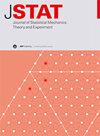Monte Carlo study of frustrated Ising model with nearest- and next-nearest-neighbor interactions in generalized triangular lattices
IF 2.2
3区 物理与天体物理
Q2 MECHANICS
Journal of Statistical Mechanics: Theory and Experiment
Pub Date : 2024-07-14
DOI:10.1088/1742-5468/ad5c58
引用次数: 0
Abstract
We investigate the frustrated J1–J2 Ising model with nearest-neighbor interaction J1 and next-nearest-neighbor interaction J2 in two kinds of generalized triangular lattices (GTLs) employing the Wang–Landau Monte Carlo method and finite-size scaling analysis. In the first GTL (GTL1), featuring anisotropic properties, we identify three kinds of super-antiferromagnetic ground states with stripe structures. Meanwhile, in the second GTL (GTL2), which is non-regular in next-nearest-neighbor interaction, the ferrimagnetic 3×3 and two kinds of partial spin liquid (PSL) ground states are observed. We confirm that residual entropy is proportional to the number of spins in the PSL ground states. Additionally, we construct finite-temperature phase diagrams for ferromagnetic nearest-neighbor and antiferromagnetic next-nearest-neighbor interactions. In GTL1, the transition into the ferromagnetic phase is continuous, contrasting with the first-order transition into the stripe phase. In GTL2, the critical temperature into the ferromagnetic ground state decreases as antiferromagnetic next-nearest-neighbor interaction intensifies until it meets the 3×3 phase boundary. For intermediate values of the next-nearest-neighbor interaction, two successive transitions emerge: one from the paramagnetic phase to the ferromagnetic phase, followed by the other transition from the ferromagnetic phase to the 3×3 phase.广义三角形晶格中具有最近邻和邻近邻相互作用的受挫伊辛模型的蒙特卡罗研究
我们采用 Wang-Landau 蒙特卡洛方法和有限尺寸缩放分析,在两种广义三角形晶格(GTL)中研究了具有最近邻作用 J1 和次最近邻作用 J2 的受挫 J1-J2 伊辛模型。在第一种具有各向异性的 GTL(GTL1)中,我们发现了三种具有条纹结构的超反铁磁基态。同时,在近邻相互作用不规则的第二个 GTL(GTL2)中,我们观察到铁磁性 3×3 和两种部分自旋液体(PSL)基态。我们证实残余熵与 PSL 基态中的自旋数成正比。此外,我们还构建了铁磁近邻和反铁磁近邻相互作用的有限温度相图。在 GTL1 中,向铁磁相的转变是连续的,与向条纹相的一阶转变形成鲜明对比。在 GTL2 中,进入铁磁基态的临界温度随着反铁磁近邻相互作用的加强而降低,直至达到 3×3 相边界。对于近邻相互作用的中间值,会出现两个连续的转变:一个是从顺磁相转变到铁磁相,另一个是从铁磁相转变到 3×3 相。
本文章由计算机程序翻译,如有差异,请以英文原文为准。
求助全文
约1分钟内获得全文
求助全文
来源期刊
CiteScore
4.50
自引率
12.50%
发文量
210
审稿时长
1.0 months
期刊介绍:
JSTAT is targeted to a broad community interested in different aspects of statistical physics, which are roughly defined by the fields represented in the conferences called ''Statistical Physics''. Submissions from experimentalists working on all the topics which have some ''connection to statistical physics are also strongly encouraged.
The journal covers different topics which correspond to the following keyword sections.
1. Quantum statistical physics, condensed matter, integrable systems
Scientific Directors: Eduardo Fradkin and Giuseppe Mussardo
2. Classical statistical mechanics, equilibrium and non-equilibrium
Scientific Directors: David Mukamel, Matteo Marsili and Giuseppe Mussardo
3. Disordered systems, classical and quantum
Scientific Directors: Eduardo Fradkin and Riccardo Zecchina
4. Interdisciplinary statistical mechanics
Scientific Directors: Matteo Marsili and Riccardo Zecchina
5. Biological modelling and information
Scientific Directors: Matteo Marsili, William Bialek and Riccardo Zecchina

 求助内容:
求助内容: 应助结果提醒方式:
应助结果提醒方式:


